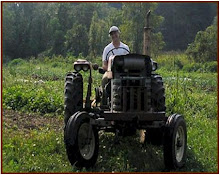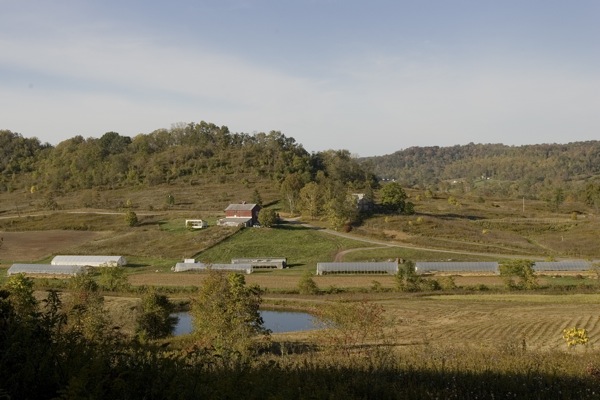ATHENS HILLS WINTER CSA:
WEEK THIRTEEN
Hello Everyone!
I hope that you are enjoying a few days of very spring-like weather! I have noticed quite a bit of green on our hillsides already and pretty soon there should be many budding trees to dot the landscape as well. All of these things remind me that it is nearing the middle of March, and before we know it we will be close to the end of our Winter CSA season. I feel like time has flown by even with the holidays mixed in. That’s a somewhat bittersweet thought. While I am so happy to be coming out of the hibernation of winter into the activity of spring, I am not excited to say goodbye to all of you. Even though we have seven weeks left, perhaps I won’t have to say so long to many of you come late April. After all, we are currently taking memberships for our Summer ’09 CSA program, and I would love to have you join us again for another flavorful season. If you are interested, feel free to contact me with any questions about next season if you haven’t already. It would be wonderful to have you join us again!
In the meantime, we have much to experience yet with this winter season. As you can tell by the offerings this week, the veggies are (slowly) kicking it into high gear as the days grow longer and warmer. The theme of the week is greens, and we’ve included quite a few. I hope that you find the information about quiche-making useful in figuring out how to use some of the greens, and the nutritional excerpt about Swiss chard intriguing. Let me know your thoughts by emailing or blogging—I would love to hear from you (see end of newsletter for addresses)! Enjoy your shares and have a great week!
Best Wishes,
Claudia
FEATURED VEGGIES
(If you have questions about any of these veggies, email me and I will do my best to get back to you right away with storage ideas, serving suggestions, etc.)
Sunflower Microgreens (Crunchy greens that harken springs eminent arrival—taste the coming season now with these great little greens.)
Mesclun Mix (We’ve combined our arugula, pe tsai & mizuna to make a great salad mix or stir fry mix for you to try this week. It will be slightly spicy eaten raw, but will mellow with a light sautéing. You decide which will hit the spot!)
Mushrooms (Whether you get the oysters or the shiitakes in your share this week, I’m sure you will find them delicious and useful for a few of your meals.)
Kale (If you are roasting your roots this week, think about sautéing our lovely kale as a great complimentary “bed” to put the roots on for serving & eating. Kale tastes great with any root veggie.)
Swiss Chard (See this newsletter for some nutritional information on this amazing green.)
Spinach (Combined with the mushrooms, our spinach makes a wonderful quiche for breakfast, lunch or dinner.)
Rutabaga (Although similar in taste and shape to turnips, these roots differ in their slight sweet buttery flavor, light yellow color, somewhat oblong shape. Chop these up and roast them just like you would the turnips below.)
Recipe: A Quiche Formula
After you have prepared the crust, there are three more steps involved before the quiche is ready to bake. These are: 1.) the cheese, 2.) the filling, and 3.) the custard—and they are all easy. Once the crust is prepared, the most difficult part is done.
THE CHEESE
This is the first layer, which gets deposited (diced or grated) directly on the crust. There is a reason why the cheese goes in first: when it melts, it forms a moisture-resistant barrier between the filling and the crust. This helps to keep the crust flaky and crisp. Recommended cheeses: Swiss varieties (especially Gruyere) and cheddar (sharp or medium-sharp). Use about ¼ to 1/3 pound, depending upon whether it’s diced or grated and the size/shape of your pan. (A straight-sided quiche pan is roomier than a pie pan.)
THE FILLING
Distribute these over the cheese.
1.) Spinach: ½ lb.—chopped and steamed, with sautéed onions, dry mustard & nutmeg.
2.) Mushrooms: ½ lb.—sliced, sautéed with scallions, oregano and thyme
3.) Asparagus: 8 to 10 slim stalks—chopped & steamed, with tarragon
4.) Broccoli: 1 large stalk—chopped, sautéed with garlic
5.) Fresh Herbs: marjoram, thyme, basil, parsley, dill, chives, etc., small amounts in various combinations, snipped in with scissors
THE CUSTARD
Beat together 3 eggs and 1 cup of milk. (NOTE: Low fat or soy milk work fine, as do yogurt or buttermilk.) Pour this over the filling. Dust the top with paprika, and bake at 375F for 35 to 40 minutes, or until firm. Cool for at least 10 minutes before slicing, and serve at any temperature.
(Recipe courtesy of The New Enchanted Broccoli Forest, 2000.)
COLORFUL CHARD
(This is an excerpt from the February-March, 2009, issue of Organic Gardening Magazine.)
Swiss Chard arms you with…
● Anthocyanins and fiber, which help prevent colon and digestive cancers.
● Iron, supporting your body’s ability to utilize oxygen.
● Vitamin A, to protect your lungs and prevent heart disease.
● Vitamin C, to boost your immune function and protect against heart disease.
● Vitamin K, to keep bones strong and allow blood to clot.
A nearly carefree vegetable (in most any climate) with often brilliantly colored stems, Swiss chard is a garden standout even without its considerable nutritional benefits. It has many of the same vitamins and minerals as kale and spinach, but offers a few benefits all of its own.
It helps prevent digestive cancers. Swiss chard contains phytonutrients called anthocyanins. Animals fed an anthocyanin extract had lower rates of colon and other digestive-tract cancers.
It protects kidneys. Diabetic animals that were given a chard extract had very low kidney damage compared to those who did not receive the extract.
Like kale it helps to maintain strong bones. Since it is loaded with vitamins, especially Vitamin K, it allows blood to clot and also keeps your bones strong. Your body can only store small amounts of Vitamin K, so eat kale and chard frequently to defend against osteoporosis.
Also like kale it protects your lungs since it has Vitamin A which protects those exposed to either first- or second-hand cigarette smoke from developing diseases like emphysema.
Like spinach, Swiss chard contains iron. In your body, iron equals energy. Low iron leads to anemia and other problems. Spinach & Swiss chard are valuable, low-calorie vegetarian sources of iron.














































































































































































No comments:
Post a Comment